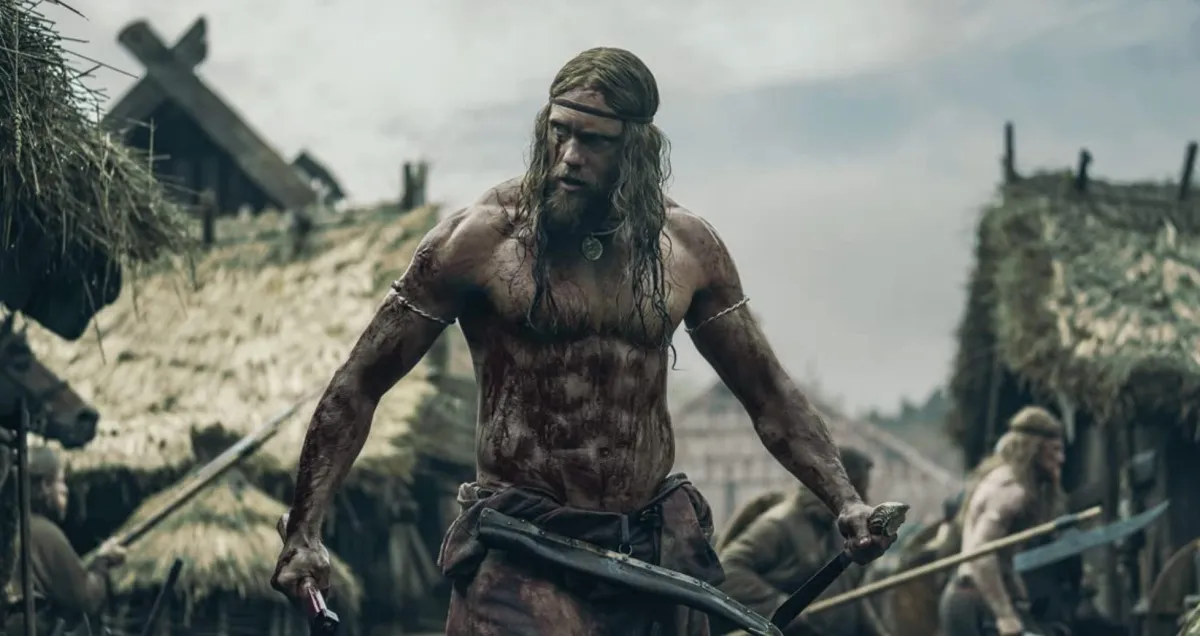In Robert Eggers’s The Northman, the Viking prince Amleth is driven by three desires: to avenge his father, to rescue his mother, and to kill his uncle, Fjölnir. There’s a lot going on in this film, with its cycles of violence and revenge, so let’s break down that jaw-dropping ending! Spoilers ahead!
The Major Events of ‘The Northman’
After his father, King Aurvandill, is killed by his uncle, Fjölnir, Amleth grows up determined to avenge him. When he finds out that Fjölnir has fled to Iceland after the takeover of his kingdom, he disguises himself as a slave in order to gain access to Fjölnir’s household. Aided by Olga, a fellow slave, Amleth begins to make plans for his revenge. He finds a fabled sword that will allow him to kill Fjölnir and hears a prophecy that he’ll kill his uncle in a lake of fire. While he waits for the events of the prophecy to come true, he wrecks havoc on Fjölnir’s court, killing Fjölnir’s older son and several nobles. Amleth then reveals his identity to his mother, Gudrún, telling her that he’s come to save her. However, Gudrún tells him that she was part of Fjölnir’s plot all along.
Eventually, Amleth and Olga escape and board a boat bound for Orkney, where Amleth has family, but Amleth finds out that Olga is pregnant with twins. Amleth realizes that Olga and their children will never be safe as long as Fjölnir lives—since Fjölnir will always seek revenge on Amleth. Amleth returns to Fjölnir’s court and kills Gudrún and her child, his half-brother. He and Fjölnir then meet in the mouth of a nearby volcano, where they fight and kill each other simultaneously, with Amleth cutting off Fjölnir’s head just as Fjölnir puts his sword through Amleth’s heart. As Amleth lies dying, he has a vision of Olga and his future children, one of whom will grow up to be a king and carry on Amleth’s dynasty. Then he’s carried to the gates of Valhalla by a Valkyrie.
The Original Folktale
There are several versions of the story of Amleth—also called Amlod or Amlóði, depending on the source—across Northern Europe. Although the details tend to vary, the core of the story generally remains the same. It starts with a king and his jealous brother. The brother kills the king so that he himself can take the throne, and then goes after the king’s son, Amleth. Amleth has to use his cunning to escape his uncle’s wrath. In some versions, he feigns a cognitive disability or mental illness in order to make his uncle believe that he’s not a threat. In other versions, he escapes to Britain, where he can safely plan his revenge. After killing his uncle and retaking the throne, Amleth is usually killed in battle himself.
Parallels to Hamlet
One of the most famous versions of the story of Amleth is, of course, Shakespeare’s Hamlet. Many of the characters in The Northman have almost direct counterparts to the Shakespeare play: Amleth is Hamlet, Gudrún is Gertrude, and Willem Defoe’s Heimir is Yorick. Like the original folktale, Hamlet swears revenge on his uncle Claudius after Claudius murders Hamlet’s father.
You’ll recall that in Hamlet, Hamlet is fatally wounded with a poisoned sword in a duel with Laertes, Ophelia’s brother, after Laertes and Claudius conspire to murder him. They prepare a poisoned cup in case Hamlet doesn’t die by the sword, but then Gertrude unwittingly drinks from it. Before he dies, Hamlet manages to kill Claudius. The final scene is as bloody as The Northman, but because the pregnant Olga is able to escape, raise her children, and continue Amleth’s family line, The Northman has a glimmer of hope that Hamlet lacks.

Destiny and the Uncanny
Like Eggers’s The Witch, The Northman treats the supernatural as an inescapable thread in the fabric of the world. Throughout his journey, Amleth encounters numerous magical and supernatural beings, including Bjork’s Seeress, the holy man who appears to tell him the location of the sword he’ll need to kill Fjölnir, and the undead warrior who guards that sword. The gods also make appearances, with Odin himself manifesting when Amleth is injured, and a Valkyrie appearing to take him to Valhalla (more on that below).
Throughout the movie, Amleth is accepting of his fate, knowing that he’s destined to kill Fjölnir in a lake of fire. His sword refuses to even leave its sheath before the appointed hour. Amleth and the other characters know that their actions are woven into wyrd, or destiny, and they can’t escape it. In this worldview, it’s only natural that otherworldly beings would come to guide the characters to their fates.
Amleth Puts a Queen on the Throne
Early in the film, Amleth is told that he’ll have to make a choice between his love for his kin and his hatred for his enemies. Amleth is ready to abandon his quest until he finds out that Olga’s pregnant, and when he receives a vision of the twins she’s carrying, he tells her that he chooses both. On the surface, that might sound like a cop-out, with Amleth trying to have everything. That’s not the case, though. Rather, Amleth realizes that both courses of action are one and the same. Eliminating his uncle is an act of love for his kin—since that’s the only way to ensure their safety, and protecting his kin, necessarily, means killing his uncle.
What’s especially interesting about Amleth’s vision of his twin children is that it’s the girl, not the boy, who wears the crown. This is in line with the Seeress’s prophecy that his child will be a “maiden king.” It’s unclear whether this queen is based on a figure from folklore or history, but it is an interesting way to end a story that revolves around men fighting for power and honor.
Valhalla and the Valkyrie
When the Valkyrie collects Amleth to take him to Valhalla, she’s not just taking him to a pleasant afterlife. According to Norse belief, Valhalla was the gathering place for the army that Odin would lead in Ragnarok. Valhalla was the highest honor a Viking could earn, and they could only enter it if they were slain in battle. This is why, early in the movie, Aurvandill tells Gudrún that he doesn’t want to die as a “shameful gray-beard.”
Olga is heartbroken when she realizes that she’ll never see Amleth again. However, from Amleth’s point of view, this is the happiest ending his story could possibly have. Olga is safe, the continuance of his bloodline is assured, and as we see in his eyes as he’s dying, he knows that he’s earned his place in Valhalla. Shakespeare’s Hamlet is a tragedy, but the end of Amleth’s story, despite the blood and gore, is actually anything but. Amleth gets his revenge, sires an heir, and earns a place at Odin’s table. Not a bad ending at all, for a Viking.
(featured image: Focus Features)










Published: May 3, 2022 03:12 pm